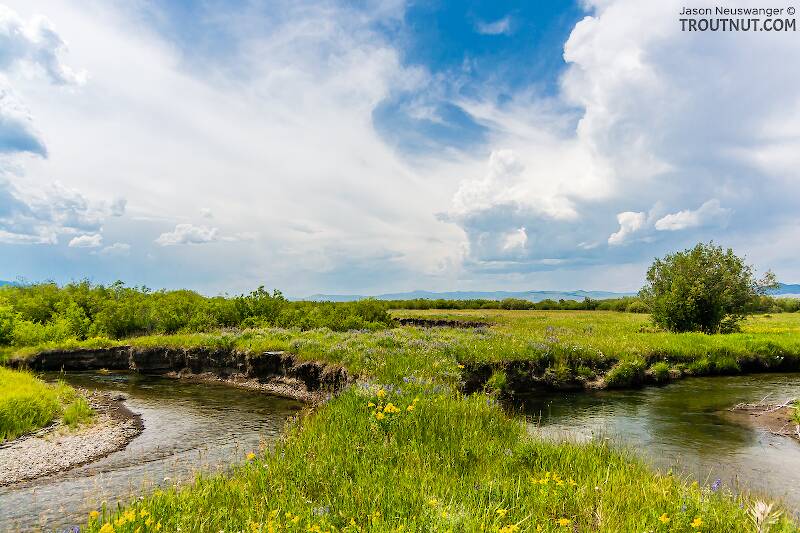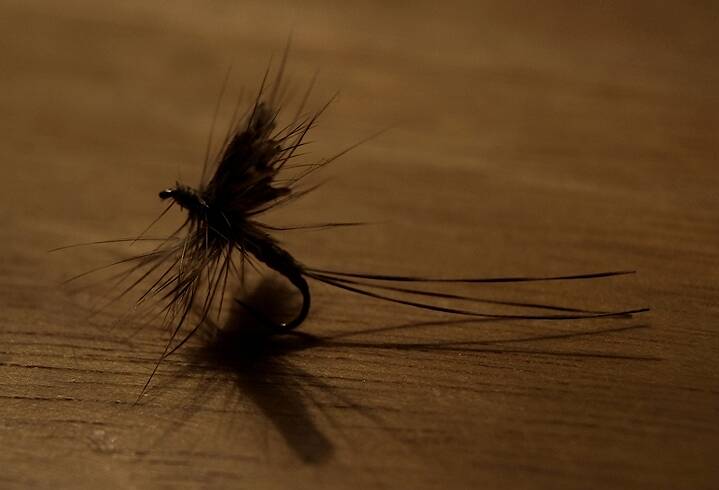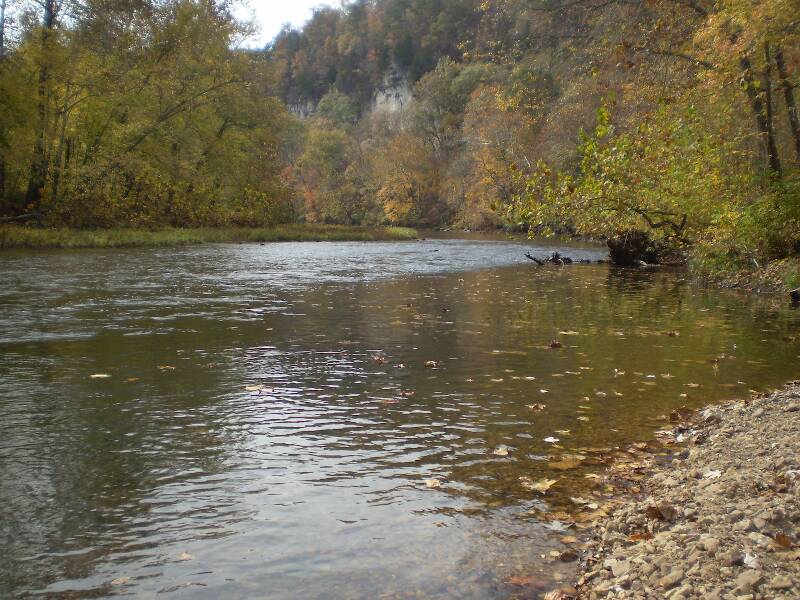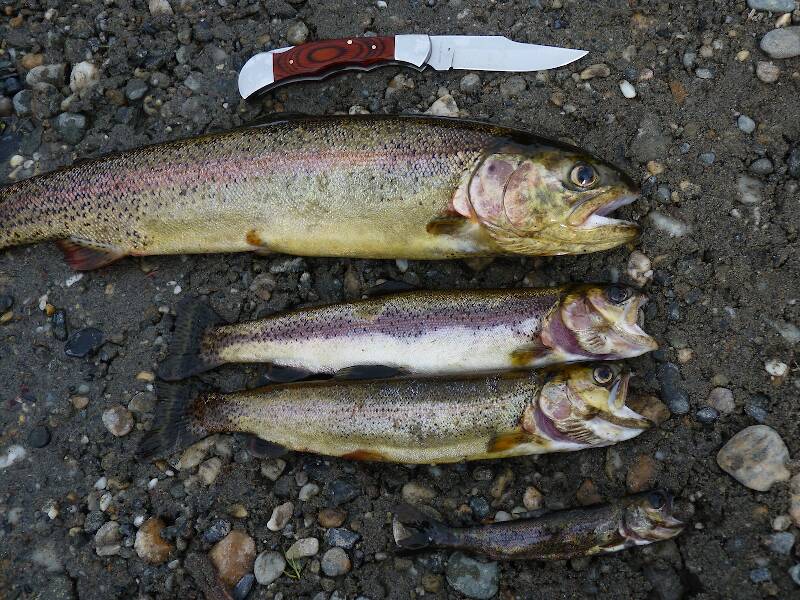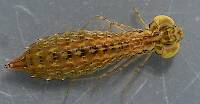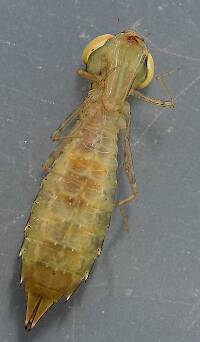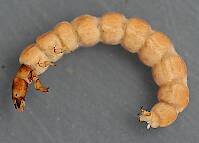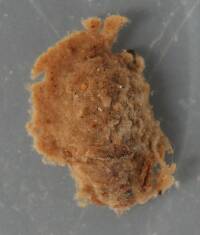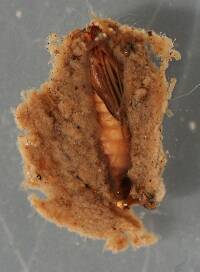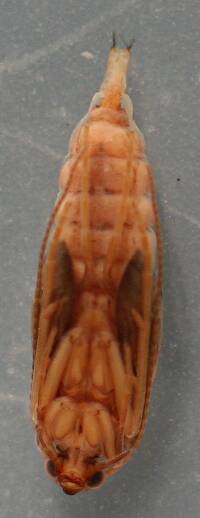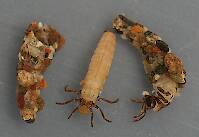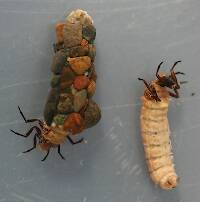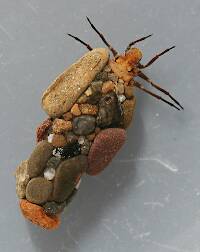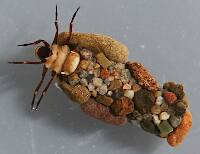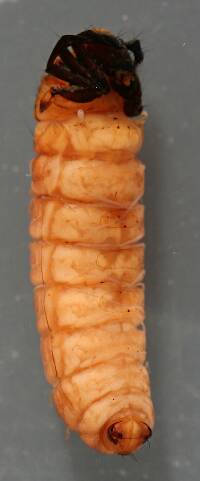
Salmonflies
Pteronarcys californica
The giant Salmonflies of the Western mountains are legendary for their proclivity to elicit consistent dry-fly action and ferocious strikes.
Featured on the forum

This specimen appears to be of the same species as this one collected in the same spot two months earlier. The identification of both is tentative. This one suffered some physical damage before being photographed, too, so the colors aren't totally natural. I was mostly photographing it to test out some new camera setting idea, which worked really well for a couple of closeups.

Troutnut is a project started in 2003 by salmonid ecologist Jason "Troutnut" Neuswanger to help anglers and
fly tyers unabashedly embrace the entomological side of the sport. Learn more about Troutnut or
support the project for an enhanced experience here.
FisherOfMen has attached this picture. The message is below.
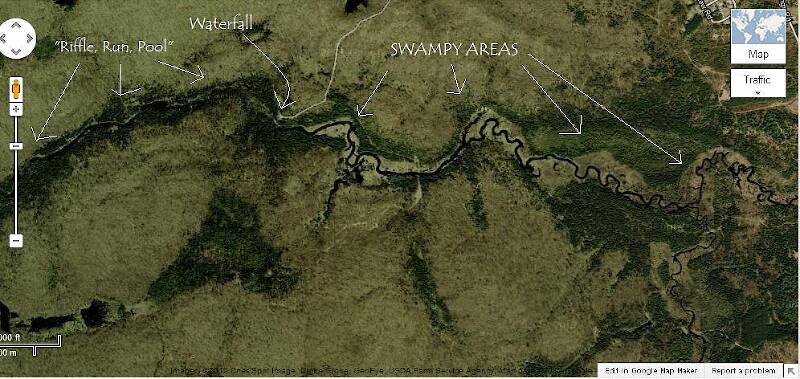
FisherOfMen on Feb 5, 2012February 5th, 2012, 12:54 pm EST
Hey guys I've been wondering about this for awhile now. Little River starts as a swampy piece that is mostly flat-surfaced slow running water with hundreds of beaver dams and debris barriers creating small riffles. The banks are muddy in some parts, with heavy vegetation everywhere, lots of animal trails cut to the water. Fly fished for 30mins. last year, nothing. 2 years ago on an 8-mile river trip a buddy and I spin-fished for 5mins and caught a palm-sized rock bass. I'm wondering if there are trout in these swampy areas. Would there be enough oxygenated water with it being slow and calm?
In the map I pointed out the swampy meandering parts. The thirty yards or so before the small waterfall there's a bunch of bends and it turns into a "trouty" type of river. I've caught 13 brookies in 20 mins on a worm years ago right at the base of the waterfall, and a small grayling (I think) a bit downstream from the falls. So there's definitely fish after the falls. (That line is a trail that ends right at the falls)
Any info. would be appreciated, I'm curious as to how rivers work. I assume the waterfall and very fast water thereafter create oxygen to sustain trout, but I really have no idea.
I want to know because the swampy portions would be a dream to fish from a canoe. Open, flat, nice views, and pure Adirondack serenity! There's TONS of food sources, I have a feeling a mosquito pattern would fare well. ;)
Its good to be able to ask a bunch of great anglers like you guys all these newbie questions. Thanks!
P.S.
Just noticed somethnig else - the swampy part is all open, and the trout part bordered by hemlock and spruce. I've heard the pine-type trees keep water cooler, could this be a factor?
In the map I pointed out the swampy meandering parts. The thirty yards or so before the small waterfall there's a bunch of bends and it turns into a "trouty" type of river. I've caught 13 brookies in 20 mins on a worm years ago right at the base of the waterfall, and a small grayling (I think) a bit downstream from the falls. So there's definitely fish after the falls. (That line is a trail that ends right at the falls)
Any info. would be appreciated, I'm curious as to how rivers work. I assume the waterfall and very fast water thereafter create oxygen to sustain trout, but I really have no idea.
I want to know because the swampy portions would be a dream to fish from a canoe. Open, flat, nice views, and pure Adirondack serenity! There's TONS of food sources, I have a feeling a mosquito pattern would fare well. ;)
Its good to be able to ask a bunch of great anglers like you guys all these newbie questions. Thanks!
P.S.
Just noticed somethnig else - the swampy part is all open, and the trout part bordered by hemlock and spruce. I've heard the pine-type trees keep water cooler, could this be a factor?
"Nothing makes a fish bigger than almost being caught." -Author Unknown
All that is necessary for the triumph of evil is that good men do nothing. -Edmund Burke
All that is necessary for the triumph of evil is that good men do nothing. -Edmund Burke
Motrout on Feb 5, 2012February 5th, 2012, 2:47 pm EST
I've spent quite a bit of time fishing the Adirondacks, and I've never done particularly well for trout in swampy, slow-moving streams...The places I've done well in are the faster, rocky pocket water streams. However, I've done all of my fishing up there late June through late July, so that's going to be the time when slower moving type streams are going to be at their worst anywhere in the east. In my experience in the Adirondacks mid-summer, unless it's a spring-hole generally the only places worth fishing are the fast, heavily oxygenated stretches of stream. The slower water just is exposed to the sun for too long and doesn't have the white-water to keep it aerated. But I know in spring and early summer it can be different, though I've never had the pleasure of fishing up there then.
But those slower stretches of river can be AWESOME to fish during the summer, depending on the river system. Just not for trout... I can think of so many (mainly) warm-water rivers like that I've learned to love: the Racquette, the forks of the St. Regis, the Saranac, others that are too fragile to name. I've spent wonderful days fishing those types of streams in my kayak out there, catching smallmouth, largemouth, perch, and even the occasional pike in total, blessed solitude, often camping on the river in the middle of the wilderness afterwards. It takes years off my life just to think about that now. And you're right about the scenery in those kinds of places. It's just magical.
I really tend to get carried away when I talk about the Adirondacks, don't I? Well, sorry about the long, pretty much off-topic post, but that shouldn't come as a surprise anymore:)
But those slower stretches of river can be AWESOME to fish during the summer, depending on the river system. Just not for trout... I can think of so many (mainly) warm-water rivers like that I've learned to love: the Racquette, the forks of the St. Regis, the Saranac, others that are too fragile to name. I've spent wonderful days fishing those types of streams in my kayak out there, catching smallmouth, largemouth, perch, and even the occasional pike in total, blessed solitude, often camping on the river in the middle of the wilderness afterwards. It takes years off my life just to think about that now. And you're right about the scenery in those kinds of places. It's just magical.
I really tend to get carried away when I talk about the Adirondacks, don't I? Well, sorry about the long, pretty much off-topic post, but that shouldn't come as a surprise anymore:)
"I don't know what fly fishing teaches us, but I think it's something we need to know."-John Gierach
http://fishingintheozarks.blogspot.com/
http://fishingintheozarks.blogspot.com/
GldstrmSam on Feb 5, 2012February 5th, 2012, 8:46 pm EST
I have very little experience in these things.
I'd say try fishing it in Spring and Fall when they come in to the shallows to feed and it is cooler. I would recommend you take a thermometer to check the temperature and compare it to a optimum trout temperature chart.
I'd say try fishing it in Spring and Fall when they come in to the shallows to feed and it is cooler. I would recommend you take a thermometer to check the temperature and compare it to a optimum trout temperature chart.
There is no greater fan of fly fishing than the worm. ~Patrick F. McManus
PaulRoberts on Feb 6, 2012February 6th, 2012, 7:48 am EST
Looking at the forest cover around the area, oxygen is not likely an issue. Now if there were agricultural fields, housing developments, and/or a sewage treatment plant, that's something different.
Temperature might be a limiting factor as to trout use of the swampy areas, and below. The rock bass might indicate this is the case. If this place heats up under summer sun (which can happen in beaver ponds) trout will change activity periods or if it's bad enough (>65F for brookies) they will move to "thermal refugia" (cold spots). Some will move into riffles where it's easier to obtain what meager 02 exists, but this is usually a short term survival act.
The third possible factor is that in those slow meanders and still ponds, the trout are MUCH easier to spook -to approach, to flash line over, to land a line near.
I'd scope it out this way:
-Use a thermometer. This will tell you a lot.
-Fish the current areas between dams where approach and angling is easier to find out if there are fish in the area.
-Spend time just observing those stillwater areas. Be VERY sneaky, get up high if you can, be very patient, and watch. Trout will reveal themselves.
Temperature might be a limiting factor as to trout use of the swampy areas, and below. The rock bass might indicate this is the case. If this place heats up under summer sun (which can happen in beaver ponds) trout will change activity periods or if it's bad enough (>65F for brookies) they will move to "thermal refugia" (cold spots). Some will move into riffles where it's easier to obtain what meager 02 exists, but this is usually a short term survival act.
The third possible factor is that in those slow meanders and still ponds, the trout are MUCH easier to spook -to approach, to flash line over, to land a line near.
I'd scope it out this way:
-Use a thermometer. This will tell you a lot.
-Fish the current areas between dams where approach and angling is easier to find out if there are fish in the area.
-Spend time just observing those stillwater areas. Be VERY sneaky, get up high if you can, be very patient, and watch. Trout will reveal themselves.
FisherOfMen on Feb 6, 2012February 6th, 2012, 5:10 pm EST
I just had a thought - Is it possible the trout simply don't expel the energy to get up past the small waterfall (6-10 ft, 45 degree angle) to the swampy areas? Could that be the only reason? I mean, if they're not on a migratory spawn they have no real reason to go up such a barrier then, right?
"Nothing makes a fish bigger than almost being caught." -Author Unknown
All that is necessary for the triumph of evil is that good men do nothing. -Edmund Burke
All that is necessary for the triumph of evil is that good men do nothing. -Edmund Burke
PaulRoberts on Feb 7, 2012February 7th, 2012, 6:12 am EST
I don't know about brook trout specifically, what constitutes a real barrier. I've watched 8" rainbows swim up almost vertical falls, digging into the thalweg where it meets rock face, and travel a good 6 feet up the face -eye level to me!
A 45deg angle doesn't sound like a real barrier, esp during periods of adequate flow.
Spend a day up there observing and fishing the easy spots to satisfy your curiosity. Who knows, you might find a hidden hole with a 15" brookie in it. That happened to a buddy of mine a couple years ago. I once found a beaver pond full of stunted little brookies, and then spied a sizable wake. Getting onto high ground I spotted a pod of browns from 15 to 20+".
A 45deg angle doesn't sound like a real barrier, esp during periods of adequate flow.
Spend a day up there observing and fishing the easy spots to satisfy your curiosity. Who knows, you might find a hidden hole with a 15" brookie in it. That happened to a buddy of mine a couple years ago. I once found a beaver pond full of stunted little brookies, and then spied a sizable wake. Getting onto high ground I spotted a pod of browns from 15 to 20+".
Strmanglr on Feb 7, 2012February 7th, 2012, 6:34 am EST
If there are trout in the river system then they can be pretty much anywhere. Certain times of the year, like Paul said, can mean trout in different spots. I think about a creek that's good for steelhead and brown trout in the spring. Don't fish it any other time than the spring. Once the temps go up it's just chub haven and not a trout to be seen.
When I first started trout fishing, like an idiot, I told the guy at the orvis shop where I had been fishing. He goes "oh, I know that river, gee I never thought there were any trout down in that stretch it's so slow". That has been where I have pulled the most and biggest trout in all the years I've fished that river.
When I first started trout fishing, like an idiot, I told the guy at the orvis shop where I had been fishing. He goes "oh, I know that river, gee I never thought there were any trout down in that stretch it's so slow". That has been where I have pulled the most and biggest trout in all the years I've fished that river.
GldstrmSam on Feb 7, 2012February 7th, 2012, 10:16 am EST
I agree with Paul R.
There is no greater fan of fly fishing than the worm. ~Patrick F. McManus
Quick Reply
Related Discussions
Topic
Replies
Last Reply
2
Jan 23, 2017
by Mcflyangler
by Mcflyangler

